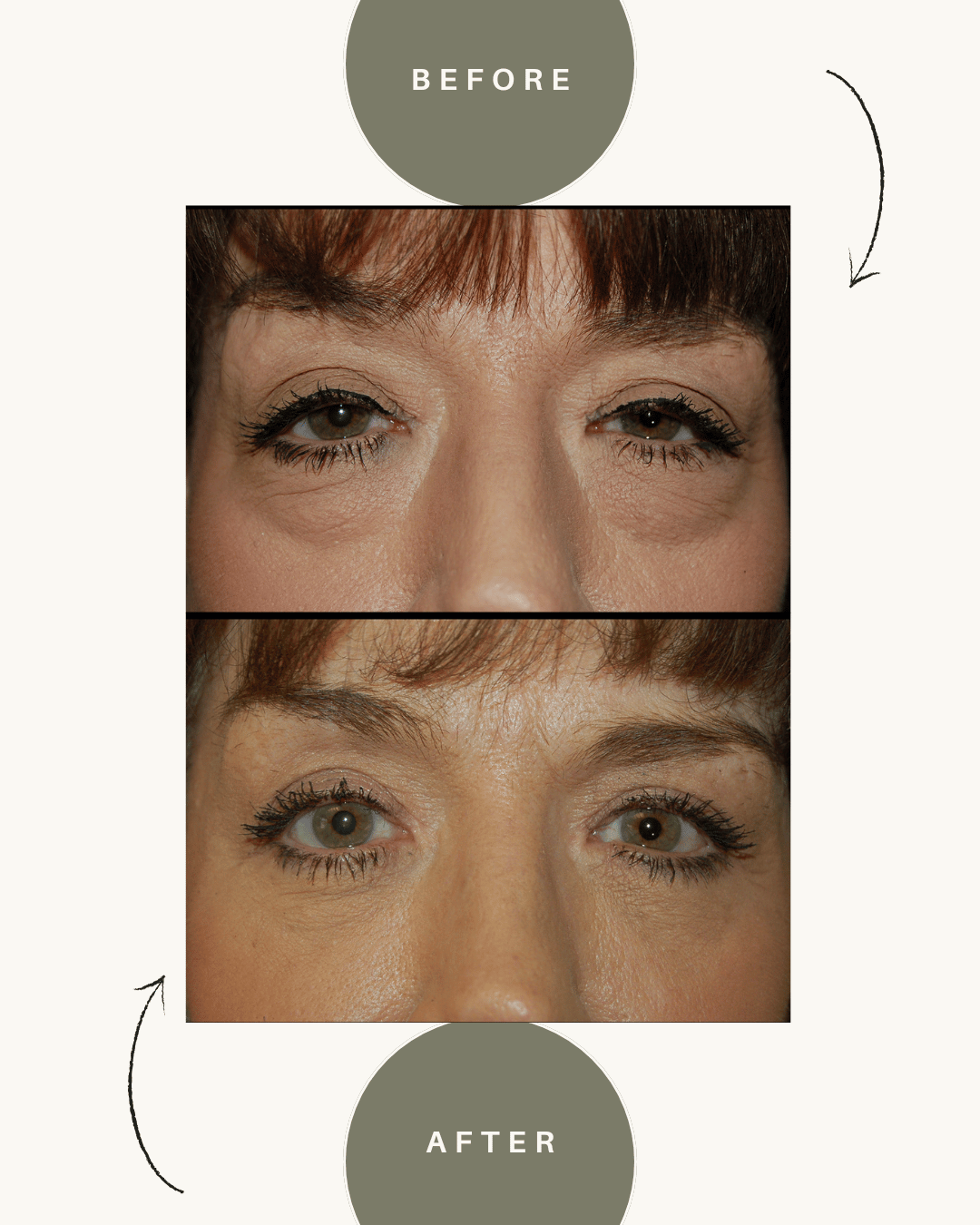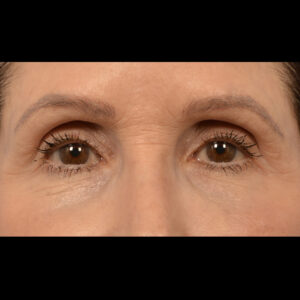
Blepharoplasty surgery, also referred to as an eyelid lift, is a popular cosmetic procedure used to enhance the appearance of the eyes. The procedure is commonly used to remove excess skin from the upper eyelids or eliminate under-eye bags from the lower eyelids.Patients can undergo a blepharoplasty to remove excess skin from the upper eyelids or bags from the lower eyelids. They can also receive an eyelid lift to treat sagging upper eyelids that otherwise make it difficult to see, which can sometimes interfere with vision.
Although blepharoplasty surgery is a top option for many patients, a laser eyelid lift offers a safe, effective alternative. Now, let’s look at the differences between laser and traditional blepharoplasties.
What Is a Laser Blepharoplasty?
Laser blepharoplasty offers a minimally invasive approach to eyelid surgery. Whereas a traditional blepharoplasty requires a facial plastic surgeon to use a scalpel, a laser eyelid lift involves a CO2 laser. As such, a laser blepharoplasty helps a surgeon make accurate, precise incisions and determine the exact amount of tissue to remove during treatment, minimizing the risk of error and enhancing the precision of the procedure. The laser technology also promotes collagen stimulation, which can aid in the skin’s rejuvenation.
What Is the Cost of Laser Blepharoplasty?
Laser blepharoplasty cost varies based on where the procedure is performed, the surgeon providing the treatment, and other factors. The surgeon explains the cost of a laser blepharoplasty prior to treatment. It’s important to consult with your surgeon beforehand to discuss pricing, payment options, and any potential additional costs that may arise during recovery.
Do I Qualify for a Laser Eyelid Lift?
Like any surgical procedure, a laser blepharoplasty is not suitable for everyone. Laser blepharoplasty is a surgical procedure, and a patient must qualify for treatment. Candidates must undergo a thorough evaluation to ensure they are healthy enough for the surgery. Issues that may disqualify a patient from a laser eyelid lift include any previously diagnosed medical conditions or health issues that jeopardize the patient’s health and well-being.
A patient must meet with a surgeon before a laser eyelid lift. A consultation with a skilled surgeon will help determine whether laser blepharoplasty is the most appropriate option for the patient. The surgeon discusses laser blepharoplasty and performs an evaluation to determine their eligibility for treatment. If the surgeon decides the patient is a good candidate for laser eyelid lift surgery, a personalized treatment plan is created.
What Are the Risks Associated with Laser Blepharoplasty?
While laser blepharoplasty offers many benefits, there are potential risks associated with the procedure. Laser blepharoplasty risks include:
- Eye irritation: Mild irritation or discomfort may occur following surgery.
- Bleeding: Although rare, some bleeding can occur during or after the procedure.
- Skin discoloration: Temporary bruising or discoloration may appear around the eyes.
- Eye muscle injuries: In rare cases, the laser could potentially damage the muscles around the eyes.
- Blurred vision: Some patients may experience temporary blurred vision as part of the healing process.
- Loss of eyesight: Although extremely rare, there is a slight risk of complications that could impact vision.
Laser blepharoplasty is only recommended if the procedure is considered safe for a patient. To minimize these risks, it is important to choose a qualified, experienced surgeon. If a surgeon believes a laser eyelid lift is too risky, alternative treatments to revitalize the eyes’ appearance can be explored.
What Happens During a Laser Blepharoplasty?
Prior to a laser blepharoplasty for the upper eyelid, a patient typically receives topical or local anesthesia, sometimes with mild sedation if needed. A surgeon then places a protective metal shield over the eye and uses a laser to make an incision in the eyelid. Excess fat and skin are carefully removed before sealing the wound.
Similarly, a laser blepharoplasty for eye bags is performed under local anesthesia, with the surgeon making a small incision on the inside of the lower eyelid to remove excess fat. The laser may also be used to resurface and tighten the lower eyelid skin, improving overall smoothness and firmness.
Unlike traditional blepharoplasty, which involves a scalpel and sutures, laser blepharoplasty may not require stitches, and recovery tends to be faster. The laser also helps minimize the risk of scarring and skin damage.
Will I Need Laser Resurfacing After Blepharoplasty Surgery?
Laser skin resurfacing is often used after blepharoplasty to improve skin tone, texture, and overall appearance. A laser skin resurfacing procedure is used to treat sun-damaged skin, acne scars, skin texture and tone issues, and facial lines and wrinkles. The treatment helps improve skin tone, texture, and pigmentation. It also revitalizes the skin. While it is not necessary for every patient, some individuals may benefit from laser resurfacing following their eyelid surgery to enhance their results.
Laser skin resurfacing can be performed after a laser or traditional blepharoplasty, but it is not required for every patient. Following a blepharoplasty, a surgeon tracks the results of treatment. If the surgeon believes a patient can benefit from laser resurfacing or any other facial rejuvenation procedure, the treatment can be performed accordingly.
What Should I Expect During Laser Blepharoplasty Recovery?


One of the key advantages of laser blepharoplasty is its relatively short recovery period. Some bruising and swelling can occur after a laser blepharoplasty, but these issues typically disappear on their own within a few days of treatment. Generally, no stitches are required during a laser blepharoplasty, and the procedure does not leave any visible scars.
Laser blepharoplasty patients can usually resume their normal activities within about one week of treatment. Most patients require time off from work or school to recover after a laser eyelid lift, with the initial recovery period lasting up to 10 days. While the recovery time is generally faster, patients should still follow post-operative care instructions closely to minimize complications and ensure optimal healing.
What Are the Results of Laser Blepharoplasty?
The results of laser blepharoplasty include more youthful and rejuvenated eyes and a balanced, natural-looking facial appearance. This procedure can address various issues, such as drooping eyelids, puffiness under the eyes, fine wrinkles, and excess skin. They are virtually identical to those associated with a traditional eyelid lift.
What Are the Advantages of Laser Blepharoplasty?
A laser blepharoplasty allows a patient to achieve results that replicate those of a traditional eyelid lift, without going under the knife. The procedure can be performed for medical or cosmetic reasons, and it helps patients correct a variety of upper and lower eyelid issues, such as:
- Drooping lower eyelids
- Under-eye bags
- Fine wrinkles around the lower eyelids
- Sagging upper eyelid skin
- Excess fat in the eyelids
Laser blepharoplasty provides several advantages over traditional methods, including:
- Precision: The CO2 laser enables more precise incisions, which can result in better outcomes and less damage to surrounding tissue.
- Less swelling and bruising: Laser blepharoplasty typically causes less post-operative swelling and bruising than traditional methods.
- Faster recovery: Patients can usually resume their normal activities in about 7 to 10 days, compared to 2 to 4 weeks for traditional eyelid surgery.
- No visible scarring: Unlike traditional blepharoplasty, which requires incisions along the eyelids, laser blepharoplasty often results in less visible scarring.
Along with the benefits mentioned above, a laser blepharoplasty causes less bruising and swelling after treatment in comparison to a traditional eyelid lift. A laser blepharoplasty also requires only about seven to 10 days of recovery time and delivers; comparatively, it takes about two to four weeks to recover from a traditional eyelid lift.
Furthermore, a laser eyelid lift procedure does not cause external scarring, as the incision is made inside the eyelid. Traditional blepharoplasty, on the other hand, involves external incisions that may leave scars. However, when performed by a skilled facial plastic surgeon like Dr. Azizzadeh, these scars are typically minimal and well-concealed within the natural eyelid creases.
Both procedures offer unique benefits—laser eyelid lifts are ideal for those seeking a minimally invasive approach with quicker recovery, while traditional blepharoplasty may be better suited for individuals with more significant excess skin or fat that requires precise surgical removal.
Which Is Better: Laser or Traditional Blepharoplasty?
The decision between laser and traditional blepharoplasty depends on various factors, such as the patient’s goals, the complexity of the surgery, and the patient’s overall health. The goal of any blepharoplasty procedure is to help a patient bolster their facial appearance with little to no risk. In some instances, a laser blepharoplasty provides the best option to accomplish this goal. Or, in other cases, a patient benefits from a traditional blepharoplasty over a laser eyelid lift.
To decide between a laser or traditional blepharoplasty, a patient should consult with a surgeon. This allows the surgeon to learn about the patient, perform a comprehensive evaluation of the patient’s eyes and other facial features, and review their medical history. In addition, the surgeon can determine if the patient qualifies for a laser eyelid lift, a traditional blepharoplasty, or both. The surgeon can also decide if the patient can benefit from other facial revitalization treatments.
Where Can I Find CO2 Laser Blepharoplasty Near Me?
There are many facial plastic surgeons who perform laser blepharoplasty treatments in cities and towns nationwide, but it is important to select a surgeon with extensive eyelid lift expertise. Many facial plastic surgeons offer laser blepharoplasty, but finding a surgeon with a strong background in facial aesthetics is key to achieving the best results.
An expert surgeon understands the dangers associated with a laser blepharoplasty procedure. The surgeon carefully evaluates a patient and determines their eligibility for an eyelid lift and other facial rejuvenation procedures. Also, the surgeon devotes time to respond to the patient’s blepharoplasty treatment concerns and questions, so the patient feels good about the procedure. The surgeon requests follow-up appointments after a blepharoplasty to ensure the patient achieves their desired results as well.
Dr. Babak Azizzadeh is globally recognized for his facial plastic and reconstructive surgery expertise, and he performs laser blepharoplasty and other facial rejuvenation procedures at the CENTER for Advanced Facial Plastic Surgery in Los Angeles. To learn more or to schedule a consultation with Dr. Azizzadeh, please contact us online or call us today at 310-657-2203.